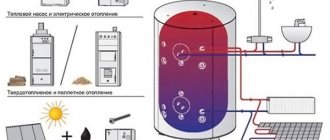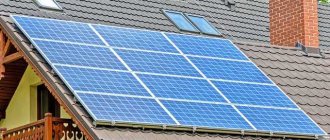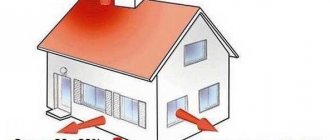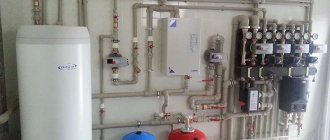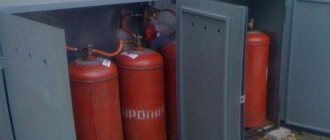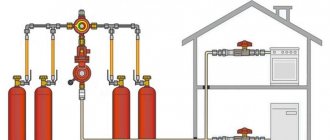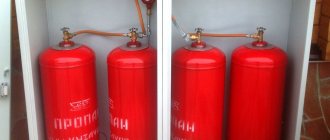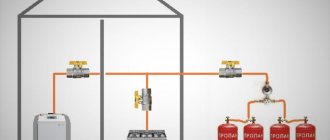Nowadays, such a rather unusual phenomenon as heating without gas is absolutely nothing new, and besides, you can easily and simply heat your own home without using expensive electricity. Of course, natural gas is the most affordable option for heating homes - it is economical, convenient and cheap, and natural gas is very common in Russia. Most people choose gas heating because it is also easy to use. However, there is one significant problem with gas: not every area has a gas pipeline, especially those remote from cities. That is why residents of such places have to resort to heating without gas.
Heating methods without gas
Insulating the house instead of heating
At first glance, giving up heating may seem like a utopia, but in fact it is quite possible to get by with high-quality insulation.
The fashion for such passive (super-economical) houses has long embraced a significant part of Europe. The passive house was designed in Germany by the Passive House Institute, and the specific heat consumption for heating should not exceed 150 kW/h per 10 sq. m. m per year. Taking into account all household needs - operation of electrical appliances, lighting, hot water, this figure should not exceed 120 kW/h per 1 sq. m per year.
Of course, there are many people who will argue that in our climate this idea is impossible, but this is not at all true. A ready-made example can be considered neighboring Finland with a more severe climate, where an entire block of passive houses was built in Helsinki, the annual electricity consumption of which is only 750-850 kW/h per 1 sq. m. m.
Future plans suggest reducing this figure to 700 kW/h. The secret to success lies in sufficiently thick walls, as well as the installation of low-e glass that blocks infrared radiation to the outside, as well as the use of heat pumps.
Due to the fact that passive houses are not yet being built in our country, it is quite difficult to determine the economic effect of such a decision.
How to heat a dacha in winter - practical recommendations
At this time of year there is no tedious weeding, planting, watering and other time-consuming work, but very interesting for people of any age. There is time to just walk around the snow-covered garden, dream and plan the beds for future planting. Clear the snow from the paths, and then warm up and drink fragrant tea infused with herbs in your home. The main thing is that there is warmth in it, which can be created, but is not always easy.
Modern technologies mastered in the production of building materials make it possible to choose any of them and even build a multi-story dacha in a short time. And immediately with a well-thought-out heating system, designed and implemented not only independently, but also with the involvement of specialists in this field.
Earth's energy can heat your home for free
One of the alternative heating systems is geothermal. It is based on the use of Earth's energy. This is the heat of the earth, groundwater, ambient air, converted by heat pumps (HP)
It is important that the temperature of the medium used by the installation is above zero
Design and principle of operation of a heat pump
To operate a geothermal system, electricity is needed to transfer the resulting heat. A heat pump, using 1 kW, produces from 2 to 6 kW of heat.
The basic principle of operation of a heat pump is to collect heat, convert it and further transfer it to the heating circuit. This is realized thanks to the design of the device itself.
The HP consists of 3 closed circuits involved in the process of obtaining heat for heating a private house:
- external - designed to collect heat from sources. Antifreeze or saline solution circulates along the circuit;
- internal - filled with refrigerant, often freon;
- heating circuit filled with coolant.
The freon filling the internal circuit is heated by the heat coming from the external circuit. Having a low boiling point, it turns into gas in the first heat exchanger - the evaporator. Then it enters the compressor, where it is compressed, as a result of which a lot of heat is released, and the temperature of the gas itself increases many times - up to 65 degrees.
Next, gaseous freon enters the next heat exchanger, called a condenser, where it leaves its heat. Freon, having parted with most of the heat, comes under pressure to the relief valve. Here the pressure drops sharply, the refrigerant cools and, having assumed a liquid state, again enters the evaporator.
The heat left by the freon in the condenser heats the liquid circulating in the home's heating system. If this system includes underfloor heating, it is possible to achieve the most efficient heating at minimal cost.
Feasibility of using TN
Heat pumps - heat pumps, which remove heat from the environment, come in different types. It all depends on the type of environment used as a source of heat intake and the type of coolant used. Accordingly, the following types of TN are distinguished:
- air-to-air;
- water-air;
- water-water;
- soil-water.
The first two types of pumps are used in air heating systems, and the second two types are used in systems with liquid coolant.
The vertical version of the heat pump is the most efficient in obtaining energy from the earth, but it is the most expensive
The most profitable from an economic point of view will be the use of water-to-water HP. This option is advisable to use if there is a non-freezing reservoir near the house into which pipes for heat intake are laid. The heat pump allows you to receive 30 W of heat from 1 m of pipeline. Depending on the area of the private household and energy needs, the appropriate number of pipes will need to be laid.
Air pumps will not replace traditional heating in regions with harsh climates. As for heat drawn from the ground, this is a very expensive project. They use a horizontal geothermal field device, vertical and cluster drilling. With the horizontal option, it is necessary to build a geothermal field to a depth greater than the freezing level. This is about 1.5-2 m. The area of such a field is impressive - from 200 m2.
HPs are capable of replacing conventional fuel in the heating system, ensuring complete energy independence for a country house
To implement a vertical and cluster project, drilling to a significant depth using drilling rigs will be required. This is a very expensive service. Equipment of this type of heat pump is advisable for cottage owners who do not think about the cost of work. Heating that uses heat from the bowels of the earth can completely replace solid fuel or gas.
Geothermal heating is best used in tandem with a water-based “warm floor” device. It allows you to get the most optimal result. Significant disadvantages include the long length of the heat collection pipeline, expensive excavation work to install the system, and the need for a large area to develop a geothermal field.
Heater, camping stove for heating food from cans, alcohol lamp
The design is known abroad as an alcohol stove, or in Russian - an alcohol lamp. The Swedish army has even adopted it.
Alcohol is used because it does not smoke when burned. This means the dishes remain clean and no soot or smoke floats in the air. The design is as simple as 3 kopecks and can be repeated in a few minutes from any available materials. For example, a beer can, coffee can or condensed milk can be used as a donor for the stove.
More specifically: you need a small iron container with an iron lid, or you will have to cover it with something.
The author used a can of Korenovsky condensed milk - it is convenient because there is an almost airtight lid on top, but even without it everything will work if there is a flat-bottomed dish on top.
So: we take a jar, a ruler, a strip of checkered leaves and a marker or any drawing or scratching object.
1. Mark a stripe on the can, moving one third from the top. The easiest way to do this is by spinning the jar while holding the marker in one position.
2. We wrap a strip of paper around the edge of the mark and fasten it with a piece of tape or glue.
3. We begin to drill, pierce with an awl or cut holes with a knife along the marked strip. In this case, I made a series of holes with a diameter of 0.8 mm through 10 mm and through 5 mm - which option is better for you - decide for yourself. You can see how they burn below. A small hole diameter for proper combustion is better than a large one, but you can make 3-5 holes a centimeter each. The uniformity of the holes is a purely aesthetic point in order to get a beautiful crown of flame like from a regular gas stove. All!
Well, not quite of course, now we’re learning how to light it up. You need to add alcohol and close the lid, 50 ml burns for 15 minutes or more. Place on a non-flammable surface and shake lightly so that the alcohol flows a little onto the outside of the jar through the holes. We light the alcohol outside and wait until it burns out. We repeat the procedure until we get a self-sustaining flame from improvised nozzles around the can. Usually it is enough to repeat 2-3 times and everything starts working on its own.
Its operating principle is simple: the flame heats the walls of the jar, the heat is transferred down the walls to the alcohol, the alcohol boils near the walls and the pressure inside increases, the alcohol vapor comes out under pressure through the holes and mixes with air and burns beautifully. Now we put a pot, a kettle, a mug on top, or we just warm ourselves around the stove - it gives a lot of heat and burns for a long time.
For greater heat transfer, you can place a homemade alcohol lamp in a larger iron container, which would heat up and release heat:
The smaller the number of holes, the harder it is to light, but the less fuel consumption and less heat from it. A liter of water boils in less than 10 minutes. It is resistant to wind, extinguish by covering, add as much fuel as needed, otherwise you will have to wait for it to burn out or pour the hot alcohol back into the container, which is not safe.
Similar options “for one mug” from a tin can with a filler hole that is closed with a coin and from an aerosol can:
Additional sources of savings
When building and technically equipping a house, it is important to correctly calculate the required boiler power. Excessive equipment capacity will lead to excessive consumption of gas fuel and increased payments
Proper layout of the thermal piping can reduce costs by up to 15%.
The installation of a collector coolant distribution system allows you to save your budget. In the bedrooms you can increase the heating at night, in the living room - during the day. It is advisable to install automated temperature sensors in the house or country house. You need to do this once, enjoy the result constantly. When the outside air temperature drops, the gas supply and the operating intensity of the heat boiler increase. The sensor can operate remotely, which is especially convenient for adjusting the heating of a country house.
A modern version of the ventilation device can significantly reduce gas consumption for heating. Installing a recuperator, in which hot air leaves the room through the inner pipe, and cold air enters through the outer jacket, warming up at the same time, allows you to heat the house with minimal fuel consumption.
You can install heated floors in living areas. This is an economical way to raise the air temperature in your home at minimal cost. Of course, you need to install gas consumption meters. They help to significantly save money on heating.
Non-volatile heating using wood and coal
It's no secret that there are a number of devices that allow you to receive heat from wood and coal without connecting to the electrical network. Here they are:
- brick ovens;
- metal furnaces;
- solid fuel boilers.
For reference. Fireplaces also successfully burn wood, but it’s only a stretch to classify them as a means of heating a home. Rather, these are interior elements that create comfort and coziness, but they generate little heat, except perhaps in one room.
Infrared heating
For infrared heating of greenhouses use:
- infrared lamps for greenhouses
- infrared heaters
If we take into account the fact that such an energy carrier as electricity is the most expensive, then it becomes clear why the plan heating system is gaining momentum.
Possessing high efficiency, they heat plants and soil without heating the air.
Then, the already heated soil and the structure of the room release heat into the surrounding atmosphere. Moreover, it is warmer below, i.e. the soil warms up well.
Savings become possible due to the fact that the infrared heater does not work constantly. It can be equipped with a thermostat that controls the temperature. The IR heater turns on only to maintain the required temperature.
It is essential that infrared radiation is completely harmless to people and plants. By using infrared heating in a greenhouse, it is possible to create different temperature bands for different types of plants, which is very comfortable for planting.
This heating is ideal when you need to raise the temperature in the greenhouse in a short period of time. The heaters reach the set temperature in just ten minutes.
Pocket warmers for smartphones
A budget option for reusable heating devices for those who do not need long-term heat. Inside these small inserts there is a gel, which, after activation, can give off heat for about 20 minutes. However, after each use it will have to be kept in boiling water for 5 minutes - which is not very convenient. But these stylish liners can warm not only your hands. Users share their life hacks: in severe frost, they put them in their pocket with their smartphone - and the battery does not die from the low temperature. Some of the models can also, if necessary, be used as “coolers” in the heat - after cooling in the refrigerator, The most popular models of gel heating pads: For Pro Hand and Body Warmers, Hotsy!
and
Hand Warmers - HotSnapZ Reusable Round & Pocket Warmers.
Heating a house without gas: there is an alternative
Today, heating a house without gas or electricity is quite affordable and allows you to quickly and efficiently heat any building, making it more comfortable and cozy.
Despite the fact that gas and electricity are considered the most modern types of fuel, they can be easily replaced with alternative heating for a private home. which, by the way, has been used by our ancestors since ancient times.
The most efficient heating of a dacha without gas can be organized using the same firewood. Heating a private home with wood is still in great demand, especially in regions where there is no possibility of an affordable connection to the main gas pipeline.
Wood burning boiler Atmos
With all this, stoves (both traditional and modern) can be used for heating and cooking, which is important, especially for small country houses. In addition to the stoves themselves, heating a country house without electricity or gas can also be organized using solid fuel boilers
In addition to stoves themselves, heating a country house without electricity and gas can also be organized using solid fuel boilers.
The basic principle of operation of the equipment is heating of the coolant (water), which in turn enters the radiators and heats the house.
Currently, for people who are looking for efficient and inexpensive heating of a country house without gas, the market offers several options for boilers, including gas generators, pyrolysis and the most classic.
This heating option has many advantages, including the availability and low cost of fuel, as well as a high level of safety (according to existing standards).
Today, heating a private home without gas or electricity is a completely acceptable and affordable option. Thanks to the active development of technology, as well as the availability of a mass of different types of equipment on the domestic market, every person whose house is located at a great distance from gas mains can provide effective heating of their home, without extra costs.
Heating a house without wood or gas: options exist
If for some reason in a country house it is not possible to use gas or wood as fuel, then it is quite possible to organize efficient heating without gas and wood, since the equipment and technologies make it possible to create productive and reliable systems.
It should be noted that for a summer house or private house without gas and firewood, electric boilers can be used - this is an excellent alternative to solid fuel or gas.
But electricity also costs quite a lot today, and therefore many people choose energy-saving heating without gas, wood or even electricity.
As a rule, such economical and profitable heating of a country house without gas involves the use of environmentally friendly technologies, directly from fuel created by nature.
One of the latest achievements of engineering technologies that provide heating without wood or gas is a heat pump.
This unit is very popular; it allows you to easily heat a country house, cottage or cottage using the heat of water, soil or the bowels of the earth.
Working principle of a heat pump
Thanks to the existence of such equipment, heating a wooden house without gas is possible and is distinguished by its environmental friendliness, accessibility and efficiency.
It should be noted that the only drawback of heat pumps is the initial installation cost, but it fully pays for itself over the entire service life, since there are no additional maintenance costs.
Advice
If you have a limited budget, we advise you to pay attention to heating systems with natural circulation
Advantages of heat pumps:
- Low fuel cost.
- Easy to install and maintain ecotherm units.
- System safety, both for human health and the environment.
- High energy efficiency, the ability to heat even the largest house at minimal cost.
Solid fuel boilers
Now people have an excellent alternative; they do not have to build a furnace if they want to give up heating with gas or electricity. Modern solid fuel boilers allow you to heat your home using firewood, coal or pallets. They are designed in such a way that the coolant in them is heated to a given temperature, and then enters the radiators intended for heating the house.
There are also universal options. For example, a gas-wood heating boiler can fully operate on both solid fuel and gas. Such options are initially equipped with two combustion chambers. Depending on the chosen model, a gas burner may be installed in them, but in some cases you will need to purchase one yourself.
You can also find gas-wood-electricity combined heating boilers on sale. In addition to fireboxes designed for the use of solid fuel or gas, they are additionally equipped with heating elements. Depending on the situation, the owner of such a unit can choose its operating mode and change the energy source at his discretion. There are models that change the type of fuel automatically. For example, you can add firewood at night, and when it burns out, the boiler itself will switch to gas heating.
But the cost of universal models is quite high. The average option will cost 200-300 thousand rubles. As a rule, they are used year-round, because these double-circuit boilers not only heat the premises, but also heat the water.
We heat your home without using gas
So, despite the widespread belief that using alternative sources of home heating is very expensive, heating without gas and electricity is a completely affordable option. In addition, this way you can quickly and efficiently heat any room. Although gas and electricity are the most modern systems, they can be easily replaced by alternative heating, which, by the way, was used by our ancestors.
Today, such heating is quite common, especially in those areas that do not have such convenience as a gas pipeline. Stoves, which serve as the main element of such heating, can be used not only for heating rooms, but also for cooking.
Firewood is one of the most affordable heating methods
Such solid fuel heating without gas or electricity is a great way to heat your home - private or countryside. The principle of its operation is that the coolant (usually water) is heated and then goes to the heating radiators, giving off its heat to the premises.
This is affordable fuel heating, and also safe based on the standards that exist today.
Technologies do not stand still and heating for a dacha without gas is now the same full-fledged method of heating your own home as traditional methods. Due to the fact that there are many models of boilers on the equipment market created using the latest technologies, any user can choose the appropriate option for himself, despite the fact that he lives in a remote area and has problems with power fluctuations.
| Solid fuel boiler | Pyrolysis boiler |
Metal furnaces
Once upon a time they were called potbelly stoves. This name dates back to the distant times of the civil war and subsequent devastation, when the simplest joys of life were associated with great wealth.
Much has changed since then, but an iron stove is still called a potbelly stove. They look different now. Many of them are equipped with fireproof glass windows, but their essence has not changed - they heat up quickly and cool down just as quickly.
Maybe that’s why this stove was called a potbelly stove, because maintaining a constantly high temperature requires a lot of wood, bourgeois style.
Folk fantasy
In the Siberian taiga huts, where it is possible to install a cast-iron stove, but it is difficult to deliver bricks, the potbelly stove is lined on three sides with large stones, rolled in by the river. It turns out beautiful and functional - the stones heat up and slowly release heat to the air.
This technique is quite applicable in the conditions of a country house - when the house is built, but the heating is not yet ready. To some extent, stones perform fire-fighting functions, absorbing random sparks and excess heat. Stone structures can serve as a reason for the designer’s flights of fancy.
The efficiency of a metal stove will increase if you equip it with a coil for heating water and connect heating batteries to it.
Electric heaters
Electricity is the most optimal alternative to gas in a private home.
Effective heating of a house using electric heaters is possible only in cases where we are talking about small rooms:
- Heat fans. The most popular in this regard are electric heat fans, which allow you to warm up the air in small rooms up to 30 m2 in a fairly short time. The most important advantage of heat fans is their low cost. Disadvantages include operating noise and dry air during operation of the device.
- Oil heaters. Externally, these electrical appliances look like ordinary heating radiators. Instead of water, oil is used as a coolant inside them: due to the fact that it does not expand when heated, it is possible to do without the use of air bleeders such as Mayevsky taps. For ease of movement from place to place, most models of oil radiators are equipped with wheels.
- Convectors. They are used more often than other electrical appliances as the main heating in a wooden house without gas. The convector has the form of a plate radiator hung on the wall. Thanks to the use of the convection method to distribute heated air, the rate of heating of rooms is an order of magnitude higher than in the case of oil batteries.
- Infrared heaters. Unlike other electrical appliances, infrared models do not heat the air, but the objects adjacent to them. For this purpose, infrared radiation emanating from special plates is used.
Idea 1 Compact model for local heating
The simplest way to make an electric heater is this one. To get started, prepare the following materials:
- 2 identical rectangular glasses, each with an area of about 25 cm2 (for example, dimensions 4*6 cm);
- a piece of aluminum foil, the width of which is no greater than the width of the glass;
- cable for connecting an electric heater (copper, two-wire, with plug);
- paraffin candle;
- epoxy adhesive;
- sharp scissors;
- pliers;
- wooden block;
- sealant;
- several ear sticks;
- clean cloth.
As you can see, the materials for assembling a homemade electric heater are not at all scarce, and most importantly, everything can be at hand. So, you can make a small electric heater with your own hands using the following step-by-step instructions:
- Wipe the glass thoroughly with a cloth to remove dirt and dust.
- Using pliers, carefully grab the glass by the edge and burn one side with a candle. The soot should evenly cover the entire surface. Similarly, you need to burn one of the sides of the second glass. In order for carbon deposits to settle on the surface better, it is recommended to cool the glass before assembling the electric heater.
- After the glass pieces have cooled, carefully use ear sticks to clean the edges no more than 5 mm around the entire perimeter.
- Cut two strips of foil, the width exactly corresponding to the width of the smoked area on the glass.
- Apply glue to the glass over the entire burned surface (it is conductive).
- Place the pieces of foil as shown in the photo below. Then apply glue to the other half and connect them.
- Then seal all joints.
- Using a tester, measure the resistance of your homemade heater yourself. After this, calculate its power using the formula: P=I 2 *R. About how to use a multimeter. We talked about it in the corresponding article. If the power does not exceed the permissible values, proceed to complete the assembly. If the power is too high, you need to redo the heating element - make the carbon layer thicker (the resistance will become less).
- Glue the ends of the foil to one of the sides.
- Make a stand from a block, installing contact pads on it connected to an electrical cord.
Using this technology you can make an electric mini heater with your own hands. The maximum heating temperature will be about 40 o. which will be quite enough for local heating. However, such a homemade product will, of course, not be enough to heat a room, so below we will provide more efficient options for homemade electric heaters.
Heating system options
So, let's look at existing equipment that will make electric heating in the house economical and cheap.
Using the boiler
Installing an electric boiler, which will heat water in the home heating system, warming up the room, is the first, least effective option. Of course, on the Internet you can see a bunch of information that talks about economical boilers that can reduce consumption by up to 80%, but all this is nonsense. The only option to reduce costs is to install thermostats and various automation systems, which will turn on only when the temperature in the room drops, as well as at certain times of the day. All other talk about new product designs or reduced power is just a publicity stunt. If you buy a small-power boiler, it will take more time to heat the water for heating the house, so that’s what it will do.
Using IR Panels
Installing infrared heaters is a more reasonable solution and, most likely, the most profitable. The fact is that these products do not heat the air in the room, but certain objects (floor, walls, closet), from which heat is subsequently transferred. If in the previous version the hot air will rise to the ceiling and immediately cool down, then in this case the heat is directed to the floor, which is more reasonable (people do not walk on the ceiling).
This diagram shows the efficiency of an economical heating system for a private home:
You see everything for yourself, so there is nothing more to prove. It should only be noted that IR devices can work more efficiently if you add thermostats to them. One regulator is enough to control three heaters in an economical heating system for a private home. We talked about how to connect a thermostat to an infrared heater in a separate article.
Using convectors
Many manufacturers convince us that an electric convector effectively heats a room and at the same time consumes a small amount of electricity. The issue is of course controversial, because, in fact, the principle of operation of the products is similar to the option with radiators (the air rises upward). The advantage of convectors is that their installation and connection are not difficult. In addition, heating of the heating element takes about one minute, which is undoubtedly faster than in the case of water radiators.
Other advantages of electric convectors include:
- low cost (from 2 to 10 thousand rubles);
- fire safety (which is especially important when installing heating in a wooden house);
- you can gradually increase the heating system (one convector for a room is not enough, buy another one and connect it to the network without any problems);
- attractive appearance;
- trouble-free operation during power surges (also important in the private sector);
- compact sizes.
Separately, I would like to recommend that you explore a heating option such as electric heated floors. You can find out a review of this heating system by watching the video:
Application of heated floors
We analyzed reviews from customers who used this option and saw that most people were satisfied with the purchase. The main thing is to additionally install a temperature regulator in order to make economical electric heating in the house with your own hands.
Choice of energy carrier
There is an inverse relationship between the efficiency of heating and the cost of equipment: the more expensive it is to purchase, the cheaper it will be to operate.
What is the most economical heating in a private house? There is no universal answer to this question.
In forests, the cheapest fuel may be firewood; in areas of coal or peat mining, coal or peat, respectively.
In some places it is possible to connect gas, but in others it is not. The most economical electric heating is expensive in any case, but there are options to choose from. To heat houses the following are used:
- gas boilers and convectors;
- solid fuel - firewood, pellets, coal, peat, briquettes, wood and crop waste;
- liquid fuel;
- electric boilers. other electrical appliances;
- heat pumps. We will not consider this option: installation of the system is very expensive, it pays off in 10 years;
- solar panels and collectors. The installation is not justified: batteries collect little energy on winter and cloudy days.
Purchasing a diesel boiler is justified when the household is large (for example, a farm) and the owners have access to cheap fuel. Diesel boilers are produced only with high power; these are not required for a medium-sized house.
But the equipment has many disadvantages: environmental damage, noisy operation, large dimensions and weight, fire hazard. The compact modification of the liquid fuel unit - the exhaust boiler - is also environmentally harmful and fire hazardous. It is low-power, but it is not installed in the house, only in utility buildings.
Another option on how to save on heating a private home: purchase a combined/universal boiler for two or more types of fuel. When purchased, it will cost more than any other.
But, firstly, under no circumstances will you be left without heating: in the absence of one energy source, you will switch to another. Secondly, there is room for savings. For example, expensive electricity can be burned only at “cheap” night time (with two-tariff payment), and during the day it can be heated with wood or coal.
Electric boilers: design features, advantages and disadvantages
There are three principles of heating the coolant that are used in modern hot water heating boilers:
- heating elements.
- Electrodes.
- Based on magnetic induction.
The first type of boiler is the most common. The coolant from the system enters the internal tank of the boiler unit, where it is heated by tubular heating elements, after which it enters the CO.
This type of equipment is safe, functional, and has built-in automation to control the temperature of the coolant and air in the room.
Electrode boilers use a completely different principle to heat the coolant. The heating element in them consists of a pair of electrodes to which high voltage is applied.
Electric current, passing from one electrode to another, heats the coolant, after which it enters the CO.
Structurally, induction boilers look more attractive, although much more complex. In this type of installation there are no (familiar to everyone) heating elements.
The coolant passes through a heat exchanger, which is part of a magnetic circuit in which a powerful magnetic field is generated. It is this that heats the heat exchanger and the coolant that circulates through the CO.
Electric heating of a country house, through indirect heat transfer, has its advantages over gas and air heating in the following: electric water heating boilers are quite reliable, have high efficiency and do not require a chimney.
As a disadvantage of such home heating, it can be noted that the use of electric boilers requires good wiring and stable voltage in the network.
Creating a water CO with an electric boiler requires significant initial costs, especially if you involve a third party to develop the project, install, configure and balance the system. You should be prepared for additional maintenance costs for such a system, which includes regular flushing of radiators, checking the operation of valves, etc.
Why electricity
Electric heating differs from classic water-stove and gas systems by being more economical and practical. We will leave the first aspect for discussion below, and describe the operational advantages here:
Electric heating is not only silent, but also environmentally friendly. It is transported safer than gas and does not emit harmful substances at all, both into the atmosphere and indoors. In the absence of waste, the need for exhaust chimneys and traction structures disappears. Heating using coal or wood is not at all comparable to electric systems. Heating with electricity does not require large one-time costs. You can make a comparison using gas as an example: to connect a house you must purchase equipment for each room, install communications, a boiler, and connect it to a common pipeline. Moreover, all this must be done together, since it is impossible to postpone connecting any part of the house to the system. And the electrical method allows you to organize sequential installation: first, the most important parts of the house are connected, and then, as funds accumulate, peripheral parts are connected. Thanks to the possibility of using a multi-tariff meter in a private house or apartment, as well as the constant development of technology in this area, electric heating is already the most economical among analogues
You should not focus on the high price of the equipment - it quickly pays for itself due to low energy consumption. Almost every method of organizing electric heating allows you to install it yourself, without many additional tools.
Of course, the use of electrical systems for heating cannot be called ideal. The work of high-quality heating of each home requires taking into account many features. In some regions, the cost of electricity can be so high that gas cannot be avoided. In old apartment buildings, it is difficult to switch to electric heating for two reasons: it is very difficult to disconnect from the central highway, and the electrical network will have to be reconnected, taking into account powerful equipment.
Despite this, the overall picture tips the scales towards electricity. For premises where there is no gas or where there is no possibility of supplying it, it is a real salvation.
Liquid fuel boilers efficiently and reliably
In terms of performance and characteristics, liquid fuel boilers are very close to gas boilers, the only significant difference is in the cost and type of fuel that is used for them: fuel oil, diesel fuel (diesel fuel or kerosene), less often rapeseed oil. Here are their most important features:
- Difficulties often arise during the delivery and storage of fuel, which is high in cost and flammable.
- When using these boilers, there is a need for an additional room - a boiler room.
- Diesel boilers have “outstripped” all others in emitting harmful substances into the atmosphere; in addition, they require high-quality protective automation.
- Liquid fuel boilers have excellent efficiency.
With a power of up to 10 kW, for example, they can easily heat a house of up to 100 m2, so they are suitable even for large buildings. There are hot water and steam boilers, most of them are compact and easy to install.
Stove heating
Stoves and fireplaces are used to heat homes. For cottages, these options are ineffective, since they do not ensure uniform distribution of heat throughout the rooms. It is better to choose them for use in dachas.
To decide which heating is more suitable for a private home, you need to choose the cheapest and most accessible fuel in your area. The price of artificial heating of a residential building directly depends on its consumption and cost. There is no universal option. Gas remains the most economical source of thermal energy
In areas where there are no main gas pipelines, you should pay attention to solid fuel and electrical resources
A strong wind will warm the house
Wind energy can be used very successfully as an alternative source for heating a country house. This resource cannot be exhausted. It tends to renew itself. To harness the power of the wind, you will need a special device called a windmill.
The principle of using wind energy
To convert wind power into an alternative heating source, a wind generator will be required. They are vertical and horizontal depending on the axis of rotation. There are many manufacturers offering their models to customers.
Wind power plants come with a horizontal and vertical axis of rotation. Greater performance for horizontally oriented
The cost depends on the material, the size of the installation itself and power. You can also build a wind generator on your own using available materials.
Any wind turbine consists of the following components:
- blades;
- masts;
- weather vane to catch the direction of the wind;
- generator;
- controller;
- batteries;
- inverter
The operating principle of a wind power plant is based on the force of the wind rotating the blades of the wind turbine. The blades attached to the mast are high above the ground. The higher, the higher the performance. So, to supply one house, a height of 25 m is sufficient.
The rotating blades drive the generator rotor. It begins to produce three-phase alternating current, requiring further modification. This current flows to the controller, where it is converted to direct current. It is used to charge batteries.
After passing through the batteries, the current is equalized and supplied to the inverter, where it is converted into single-phase alternating current with a frequency of 50 Hz and a voltage of 220 Volts. Now it can be used for domestic needs, in an electric heating system.
Features of the location of wind turbines
Wind turbines are capable of operating under certain conditions. Firstly, a wind generator is a rather voluminous structure that requires an impressive area for the device. A small appliance is not able to meet energy needs. Its height should be at least 10 m higher than surrounding houses, trees and other buildings, and power lines and other objects should be located 100 m from the wind turbine. This requirement is not always feasible - not all owners of private houses have personal plots of sufficient area.
Refusal from gas, wood and coal
Traditional heat sources, used for heating for many years, can be abandoned. Surprising as it may seem, it is quite real. Many ardent opponents argue that it is impossible to replace natural resources with environmentally friendly analogues. The alternative is the energy of the sun, the power of the wind, the heat hidden in the bowels of the earth, waste from production and human activity. Such options are relevant in the modern world, given the general pollution of the environment.
Alternative sources can provide a country house with electricity and thermal energy
Another significant advantage is tangible savings when using environmental sources of spontaneously renewable energy. At first glance, it seems that this is unreasonably expensive and is unlikely to pay off. Having understood in more detail the features of each method, you can see that the eco-project pays off in 4-7 years, and then only the current costs of maintaining the used mechanisms in working order remain.
The possibility of fully replacing conventional fuel with an alternative one has been proven by more than one real example. Homeowners around the world are turning to green heating options. In our country, only a few decide to radically change their usual fuel, which is becoming more expensive every year.
The main problem with ecofuels is the significant capital investment at the initial stage. After all, you first need to calculate in detail the amount of energy required for a particular house or cottage. Then find out what type of eco-resources are most beneficial in a particular area. Next, you have to draw up a plan for the location of the energy-generating equipment, buy everything you need and install it.
If all these issues are dealt with by relevant specialists, then the final cost of eco-heating will be very high. To save money, you can try to do it yourself. To do this, you will have to immerse yourself in the topic of alternative energy sources in order to refuse to attract outside help. In this case, the cost of the project will be several times cheaper.
It is the second option that many owners of private houses choose. Their practice proves that becoming energy independent is quite possible. You can completely or partially replace traditional fuel - it all depends on the size of the household, financial capabilities at the initial stage, and the chosen heating option.
